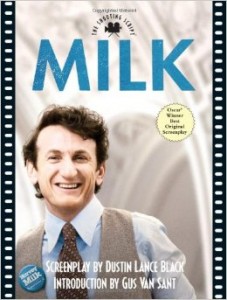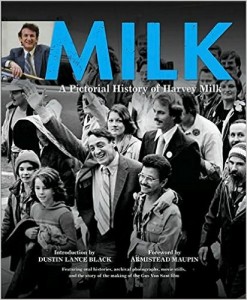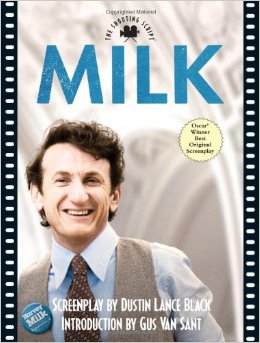 Milk: The Shooting Script
Milk: The Shooting Script
By Dustin Lance Black
Newmarket Press, 130 pages, $19.95
 Milk: A Pictorial History
Milk: A Pictorial History
of Harvey Milk
Introduction by Dustin Lance Black
Newmarket Press, 144 pages, $19.95
THE PUBLICATION of Dustin Lance Black’s Oscar-winning script of Gus Van Sant’s film Milk provides an opportunity to experience the film in a much fuller way. This is because, as the “shooting script,” it contains scenes that were either trimmed or cut from the film altogether, as well as extensive scene notes from Black that further illuminate the creative decisions he made as he plotted and paced his story. The notes also provide glimpses into his collaboration with Van Sant as the story began to take life on film.
Many GLBT moviegoers of a certain generation come to Milk with an extensive knowledge—or even, for some, a personal recollection—of the man and the events that the film depicts. For these viewers, there have no doubt been questions about why key individuals and events were left out of the story. Black addresses many of these issues in his scene notes. For example, in discussing his decision to end the story before the White Night Riots, Black explains: “The story of that trial and the night of violence that followed is a compelling one. It was very tempting to dive in, but emotionally the film felt over when Harvey was gone. So I decided to end it where Harvey would have likely ended it, with his message of hope, not violence.”

What comes through clearly here is Black’s personal investment in this film, something that was evident in his emotional acceptance speech for Best Original Screenplay at the Academy Awards ceremony. Black is obviously too young to have known Milk personally, but in his research for the script he did get to know many of those who are portrayed in the film, and these relationships enabled him to produce a script that offers at once a highly political story and an intensely personal one. This rich and deeply human portrait of a very political man is no small feat, and the ability of Milk to pull it off is as much a result of Black’s decisions as it is of Van Sant’s direction (not to mention Sean Penn’s masterful performance as the title character).
It’s no accident that the events around 1978’s Proposition 6 as depicted in the film so closely parallel the eerily similar controversy around Proposition 8 last November. In an interview included in the book, Van Sant notes how his initial reaction to Black’s script was that it “seemed to be entirely political.” Van Sant actually pushed Black to include more dialog so as to illuminate Milk’s personal dimensions, a suggestion that Black resisted in favor of conveying the personal as “subtext” to the many political conversations. As Van Sant concedes, Black’s approach worked.
As with most creative work, the ultimate success of the enterprise usually turns on the small details. Black admits to a few artistic liberties. The scene in which Milk attends the baptism of Dan White’s son in church never quite happened that way—Milk actually attended a baby shower in White’s home. Black explains that the change allowed him to portray White’s religious views “more vividly.” (Interestingly, White’s son showed up on the set the day the scene was shot to remind the screenwriter of the facts.)
Black had the luxury—though it was also, perhaps, a burden—of drawing upon extensive interviews, film footage, and other historical records as he fashioned his script. This necessitated many difficult choices in terms of what to include and exclude. As both Van Sant and Black note in the interview, the director pushed the screenwriter to trim his original draft considerably. One scene in which Black was scrupulously attentive to detail is perhaps the film’s most riveting: White’s murder of Milk. “The details of the murder are pulled directly from the police and coroner’s reports,” says Black in the scene note. “It was important to me that it be re-created as accurately as possible, because I knew all I would have is an epilogue card regarding the jury’s decision to define this event as manslaughter. I wanted that injustice to be accurate and clear.”
In tandem with its publication of Black’s script, Newmarket Press has also published Milk: A Pictorial History of Harvey Milk. The book includes a foreword by Armistead Maupin in which he relates the poignant story of Steve Beery, who was Milk’s lover at the time of his death, and an introduction by Black that provides an eloquent personal and political context for the film. Aside from these prefatory essays and a small section at the end of the book devoted to the making of the film, this is the story of Milk’s life as told movingly in photos, in the words of those who knew him, and in Milk’s own—often deliberately provocative—words (including the full text of his famous “Hope” speech).
The history is a fitting companion to the film script because it covers events that Black and Van Sant were not able to include, such as Milk’s 1976 race for an Assembly seat, and the White Night Riots. There’s also a two-page spread devoted to Dan White, including his 1985 obituary from Time magazine and a strangely disturbing photo of a buff, shirtless White showing off a shamrock tattoo. The section devoted to the movie contains some interesting pairings of film stills next to photos of the actual people and events depicted. Both books not only enhance one’s experience of the film; they are valuable additions to the Milk canon.







Discussion1 Comment
Pingback: 12 openly gay Oscar winners you have never heard about | Meaws - Gay Site providing cool gay stories and articles